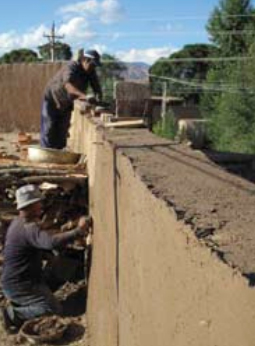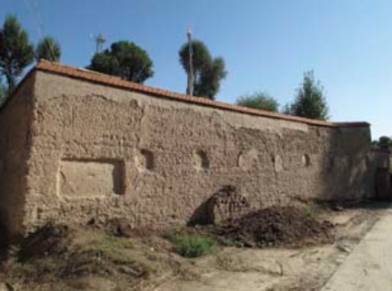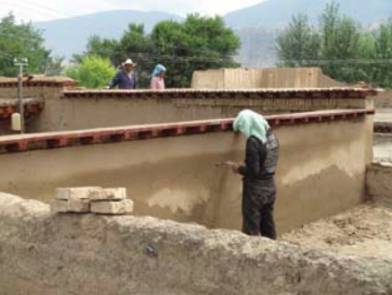
The most vulnerable part of traditional homes in Qinghai are the mud walls and the mud roofs. Rammed earth is the most common material used for the outer walls. Rammed earth walls locally known as kyang are built with local soil, and construction skills are locally available. Thick soil walls make good isolation, keeping the indoor temperature comfortable for living, cool in summer and warm in winter. The purely natural material is easy to maintain and to recycle; it is very friendly to the natural environment. However, with the appearance of new construction material, people have started to replace the kyang wall into brick and concrete blocks, often with encouragement from local governments. This is not only changes the traditional building characteristics and appearance, but it is also a pity to abandon nature-friendly materials. The kyang wall’s weak point is at the top, where it is exposed to erosion by rain and wind. THF proposed to upgrade the kyang wall by adding a stone- or brick parapet on the top. THF and the residents cooperated to carry out this project, THF mainly provided the materials and skilled masons, and residents contributed assistant labors and soil, dry grass etc free materials from their field. THF implemented upgrading of kyang walls in three different villages (two in Guide and one in Jentsa), aiming to preserve traditional housing with sustainability. The perimeter of courtyard houses are approximately between 35 to 60 meters, the construction period was about 10 days per courtyard house. The Costs for each houses were about 2200 to 5000 RMB/ house, depends on the size of house. In total, 12 houses were upgraded in three villages as a model case.

Location A: Ragen village
Ragen village is an early Tibetan settlement in the Guide basin, about 3 km away from the center of Guide county town. There are about 40 house holders currently, inhabited by Tibetan, Han-Chinese and Hui-Muslims. THF’s offer of upgrading was taken up by 7 old courtyard houses with over 100 years history.
Location B: Xiapai village
A famous Yul-lha temple (local soil deity) is located in this village. THF upgraded 2 courtyard houses, including the oldest house in the village.

Location C: Nangra village
Nangra is the center of an ancient Tibetan tribe known as “Nangra Chong Gye”, the allied settlement of about 700 house holds, which was ruled by a Tibetan local ruler until 60 years ago. Despite the political developments, the community structure and village layout with vernacular buildings are still intact. Three courtyard houses participated in housing upgrading as model cases. In this case, the walls were additionally fitted with wooden eaves to create a small overhang structure to protect the vertical walls better from rain. Each courtyard house took about two weeks to complete, carpentry work was necessary for the timber structure, so the THF contribution was about 3500 RMB 5000 RMB/ house for this upgrading project. Results: three homes have been upgraded, and a village-wide workshop was held involving local artisans.
This project was funded by MISEREOR.